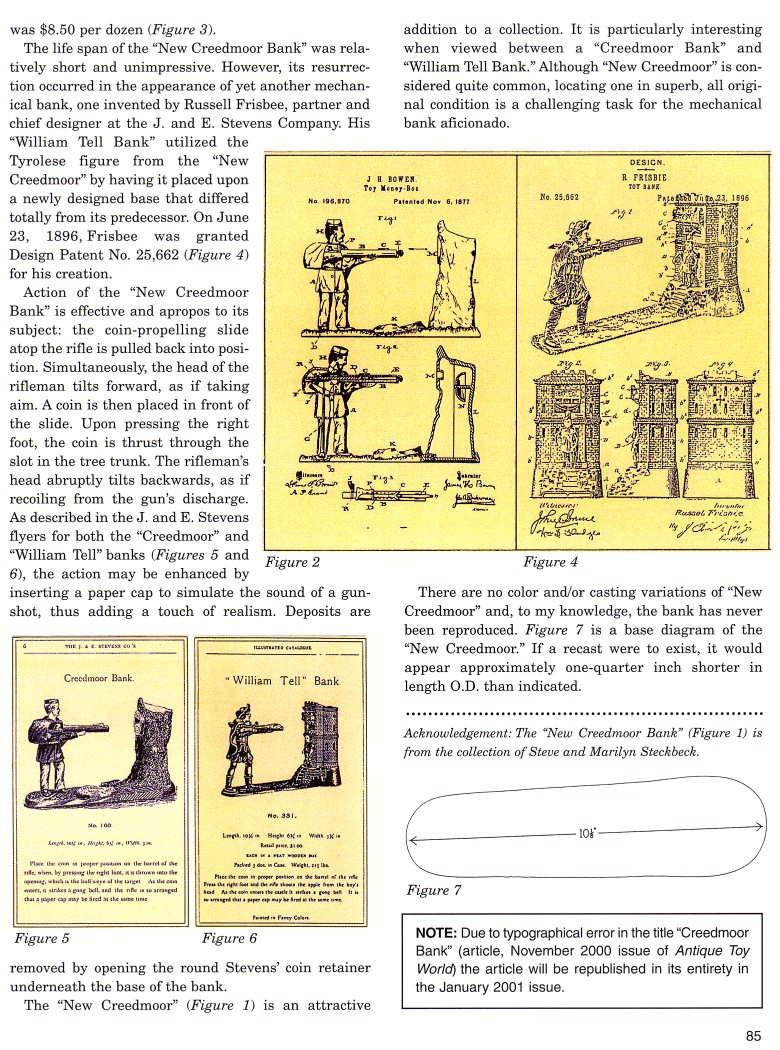|
New Creedmoor Bank
by Sy Schreckinger – ANTIQUE TOY WORLD Magazine – December,
2000
Unique and ingenious are descriptions befitting
a creation that demonstrates the triumph of Yankee ingenuity. Viewing the
"New Creedmoor Bank" represented in Figure 1, the phrase "mix and match"
comes to mind. It was the clever integration of components from two
different mechanicals which produced a third distinctly disparate example.
On November 6, 1877, Mr. James H. Bowen of Philadelphia, Pennsylvania
had been granted Patent number
196,870 for his "Creedmoor Bank" (Figure
2). The subject of his invention was a rifle-wielding marksman firing a
coin into a targeted tree trunk. Bowen subsequently assigned manufacturing
rights to the J. and E. Stevens Company of Cromwell, Connecticut. Stevens
produced the bank for several years, during which time the mechanical
enjoyed unrivaled popularity.
It is generally assumed that in, or about, the year 1890, sales of
the "Creedmoor Bank" began to wane. In a feeble attempt to freshen the
merchandise, J. and E. Stevens implemented two major modifications.
Firstly, the figure of the "Creedmoor" soldier was replaced with the
figure of a Tyrolean rifle man, and secondly, a new designation was
incorporated upon the top of the "Creedmoor" base. The "New Creedmoor
Bank" was now ready to be introduced as part of Stevens' virgin line of
mechanicals. Interestingly, a Selchow and Righter toy jobber's catalog,
circa 1894, advertised the "New Creedmoor" as the "Tyrolese Bank." Its
selling price was $8.50 per dozen (Figure 3).
The life span of the "New Creedmoor Bank" was relatively short and
unimpressive. However, its resurrection occurred in the appearance of yet
another mechanical bank, one invented by Russell Frisbee, partner and
chief designer at the J. and E. Stevens Company. His "William Tell Bank"
utilized the Tyrolese figure from the "New Creedmoor" by having it placed
upon a newly designed base that differed totally from its predecessor. On
June 23, 1896, Frisbee was granted Design Patent No. 25,662 (Figure 4) for
his creation.
Action of the "New Creedmoor Bank" is effective and apropos to its
subject: the coin-propelling slide atop the rifle is pulled back into
position. Simultaneously, the head of the rifleman tilts forward, as if
taking aim. A coin is then placed in front of the slide. Upon pressing the
right foot, the coin is thrust through the slot in the tree trunk. The
rifleman's head abruptly tilts backwards, as if recoiling from the gun's
discharge. As described in the J. and E. Stevens flyers for both the
"Creedmoor" and "William Tell" banks (Figures 5 and 6), the action may be
enhanced by inserting a paper cap to simulate the sound of a gunshot, thus
adding a touch of realism. Deposits are removed by opening the round
Stevens' coin retainer underneath the base of the bank.
The "New Creedmoor" (Figure 1) is an attractive addition to a
collection. It is particularly interesting when viewed between a
"Creedmoor Bank" and "William Tell Bank." Although "New Creedmoor" is
considered quite common, locating one in superb, all original condition is
a challenging task for the mechanical bank aficionado.
There are no color and/or casting variations of "New Creedmoor" and,
to my knowledge, the bank has never been reproduced. Figure 7 is a base
diagram of the "New Creedmoor." If a recast were to exist, it would appear
approximately one-quarter inch shorter in length O.D. than indicated.
Acknowledgement: The "New Creedmoor Bank" (Figure 1) is from the
collection of Steve and Marilyn Steckbeck.
NOTE: Due to typographical error in the title "Creedmoor Bank"
(article, November 2000 issue of Antique Toy World) the article will be
republished in its entirety in the
January 2001 issue.
|


